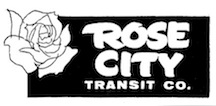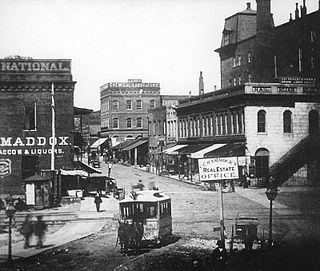
Atlanta is the capital and most populous city of the U.S. state of Georgia. It is the seat of Fulton County, the most populous county in Georgia, although a portion of the city extends into neighboring DeKalb County. With a population of 498,715 living within the city limits, it is the eighth most populous city in the Southeast and 38th most populous city in the United States according to the 2020 U.S. census. It is the core of the much larger Atlanta metropolitan area, which is home to more than 6.1 million people, making it the eighth-largest metropolitan area in the United States. Situated among the foothills of the Appalachian Mountains at an elevation of just over 1,000 feet (300 m) above sea level, it features unique topography that includes rolling hills, lush greenery, and the most dense urban tree coverage of any major city in the United States.

Sandy Springs is a city in northern Fulton County, Georgia, United States, and an inner ring suburb of Atlanta. The city's population was 108,080 at the 2020 census, making it Georgia's seventh-largest city. It is the site of several corporate headquarters, including UPS, Newell Brands, Inspire Brands, Focus Brands, Cox Enterprises, and Mercedes-Benz USA's corporate offices.

Hartsfield–Jackson Atlanta International Airport, also known as Atlanta Hartsfield–Jackson International Airport, Atlanta Airport, Hartsfield, Hartsfield–Jackson and, formerly, as the Atlanta Municipal Airport, is the primary international airport serving Atlanta, Georgia, United States. The airport is located 10 mi (16 km) south of the Downtown Atlanta district. It is named after former Atlanta mayors William B. Hartsfield and Maynard Jackson. ATL covers 4,700 acres (1,900 ha) of land and has five parallel runways. Hartsfield-Jackson Airport has been the world's busiest airport by passenger traffic since 1998, with over 93.6 million passengers.

Maynard Holbrook Jackson Jr. was an American attorney and politician who served as the 54th mayor of Atlanta, Georgia from 1974 to 1982, and again as the city's 56th mayor from 1990 to 1994. A member of the Democratic Party, he was the first Black mayor of Atlanta and of any major city in the South; his three terms made him the second longest-serving mayor in the city's history, after six-term mayor William B. Hartsfield.

The Denver Tramway, operating in Denver, Colorado, was a streetcar system incorporated in 1886. The tramway was unusual for a number of reasons: the term "tramway" is generally not used in the United States, and it is not known why the company was named as such. The track was 3 ft 6 in narrow gauge, an unusual gauge in the United States, but in general use by railways in Japan, southern Africa, New Zealand, and Queensland, Australia.
Timeline of mass transit in Atlanta:

The Atlanta Transit Company (ATC) was a public transport operator based in Atlanta, Georgia, which existed from 1950 to 1972. It was the immediate predecessor of the Metropolitan Atlanta Rapid Transit Authority (MARTA).

A dollar van is a privately-owned type of bus service used to carry passengers in the United States. Dollar vans are typically modified passenger vans, and often operate in urban neighborhoods that are under-served by public mass transit or taxis. Some of the dollar vans are licensed and regulated, while others operate illegally. Passengers may board them at designated stops along their route or hail them as share taxis.
Georgia Power is an electric utility headquartered in Atlanta, Georgia, United States. It was established as the Georgia Railway and Power Company and began operations in 1902 running streetcars in Atlanta as a successor to the Atlanta Consolidated Street Railway Company.

The San Diego Metropolitan Transit System is a public transit service provider for Central, South, Northeast and Southeast San Diego County. The agency directly operates a large transit system that includes the MTS Bus, San Diego Trolley light rail, and Rapid bus rapid transit services. The MTS also controls the San Diego and Arizona Eastern (SD&AE) freight railway and regulates taxicabs, jitneys, and other private for-hire passenger transportation services.

Streetcars or trolley(car)s were once the chief mode of public transit in hundreds of North American cities and towns. Most of the original urban streetcar systems were either dismantled in the mid-20th century or converted to other modes of operation, such as light rail. Today, only Toronto still operates a streetcar network essentially unchanged in layout and mode of operation.

The General Strike of 1910 was a labor strike by trolley workers of the Philadelphia Rapid Transit Company that grew to a citywide riot and general strike in Philadelphia, Pennsylvania.

The Rose City Transit Company was a private company that operated most mass transit service in the city of Portland, Oregon, from 1956 to 1969. It operated only within the city proper. Transit services connecting downtown Portland with suburbs outside the city but within the Portland metropolitan area were run by other private companies, mainly a consortium of four companies known collectively as the "Blue Bus" lines.
The transportation system of Georgia is a cooperation of complex systems of infrastructure comprising over 1,200 miles (1,900 km) of interstates and more than 120 airports and airbases serving a regional population of 59,425 people.

Streetcars originally operated in Atlanta downtown and into the surrounding areas from 1871 until the final line's closure in 1949.
In Atlanta, Georgia, trolleybuses, generally called trackless trolleys there, were a major component of the public transportation system in the middle decades of the 20th century, carrying some 80 percent of all transit riders during the period when the system was at its maximum size. At the end of 1949 Atlanta had a fleet of 453 trolleybuses, the largest in the United States, and it retained this distinction until 1952, when it was surpassed by Chicago.
Atlanta's transportation system is a complex infrastructure of several systems, including 47.6 miles of heavy rail, 91 bus transit routes, 1,600 licensed taxis, a comprehensive network of freeways, the world's busiest airport and over 45 miles of bike paths.

In the New York metropolitan area, dollar vans are a form of semi-formal public transportation. Dollar vans serve major corridors in Brooklyn, Queens, and the Bronx that lack adequate subway and bus service. A variant of the dollar van, the jitney, also serves areas in eastern New Jersey and transports them to Manhattan.

The United Electric Railways Company (UER) was the Providence-based operator of the system of interurban streetcars, trolleybuses, and trolley freight in the state of Rhode Island in the early- to mid-twentieth century.
The Atlanta streetcar strike of 1916 was a labor strike involving streetcar operators for the Georgia Railway and Power Company in Atlanta, Georgia. Precipitated by previous strike action by linemen of Georgia Railway earlier that year, the strike began on September 30 and ended January 5 of the following year. The main goals of the strike included increased pay, shorter working hours, and union recognition. The strike ended with the operators receiving a wage increase, and subsequent strike action the following year lead to union recognition.











